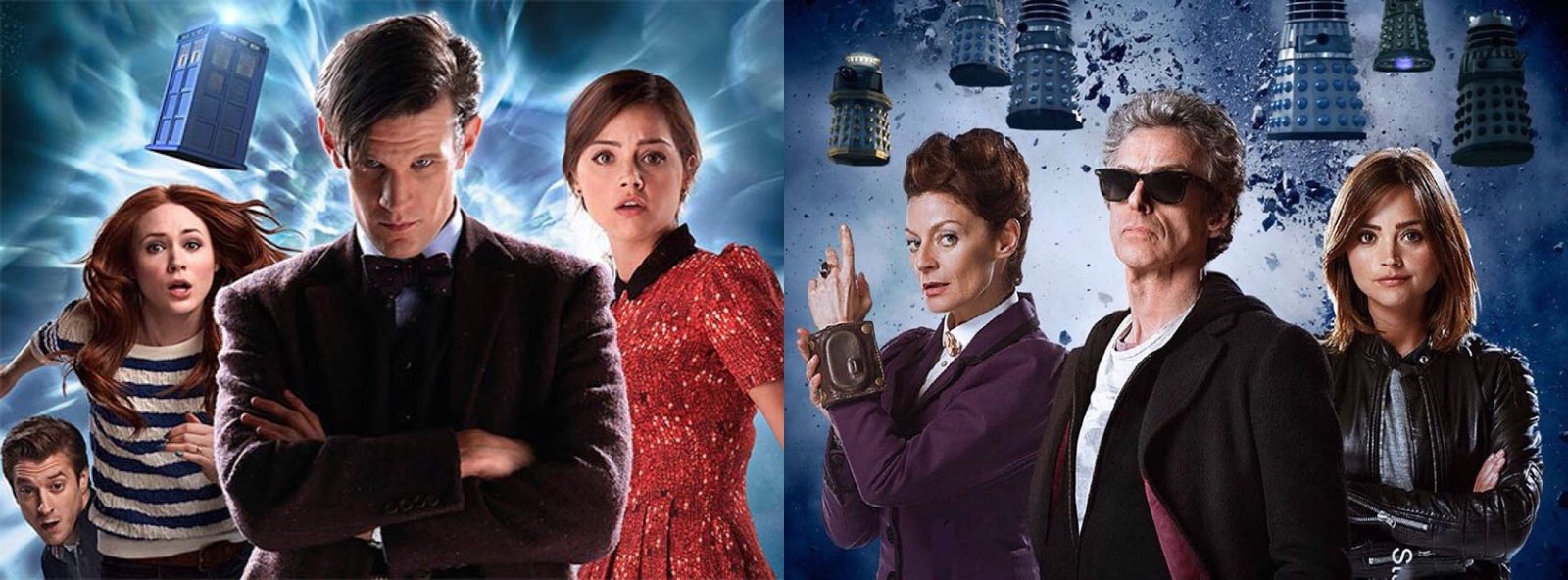During the buildup towards Doctor Who‘s 50th anniversary celebration, Matt Smith’s final series lacked one of the show’s traditional storytelling formats that we all continue to love: two-parters. Instead, Series 7 entirely consisted of standalone “blockbusters” without a proper story arc, whilst being split like its predecessor. Plus, also a letdown, no cliffhangers at all (excluding The Name of the Doctor).
This was a real disappointment to Doctor Who fans alike, and certainly not commemorative for the golden milestone at all.
Here’s what Steven Moffat explained back in 2011:
“The big thing is, nothing in the next run is starting out as a two-parter. At this stage, everything is a single episode, and the only reason anything will become a two-parter is if we think it needs to be; not so much that the story is too long for 45 minutes, because nothing is too long for 45 minutes, but if it feels as though there are two distinct stages to the story.
“I was looking at the facts and stats and it’s not true that the two-parters save us money. We’ve assumed it for years. They don’t save us money at all. Not a penny. So what’s the point in them? The viewing figures always go down. The AI [Audience Appreciation Index] goes down, even if the second episode is the better one. The press coverage goes down. The trailers are a bit boring. I want to be able to say, every week, we’ve got a big standalone blockbuster, and then a trailer that makes it look like nothing compared to what’s going to happen next week! That’s the form for next year.”

I remember feeling confused but outraged by the decision, after initially thinking it was some sort of prank on the readers; definitely too late for April Fools. Thing is though, how the heck can you do a 45-minute “blockbuster”? Literally half the length (or a third) of a motion picture!
That reminds me. Series 9, on the other hand, mostly consisted of some epic two-parters with a proper story arc. Imagine such format being used for Series 7; wouldn’t that have made the 50th anniversary more memorable?
Whilst the news of Series 9 was coming along, before airing back in 2015, Steven Moffat revealed that there was going to be “a substantial difference between the two halves.” The overall results turned out to be beyond fantastic – a unique experiment that delivered some high quality storytelling and improvement to the writing. Not all would agree, but that’s what I do enjoy about Peter Capaldi’s second series. I call this a real homage to the Classic era which comprised of multi-part serials (with only a very few standalone episodes).
If they decide to produce a full series without two-parters and/or any kind of story arc, then it wouldn’t turn out to be highly successful. That was indeed the case for Series 7, as it comprised of a whole load of dramatic changes; notably the TARDIS interior’s complete makeover in The Snowmen along with a new set of opening titles and theme tune arrangement.
So what really did go wrong?

First of all, there was no obvious story arc for Amy and Rory’s departure over the course of the first half; it only came at the very last minute during The Angels Take Manhattan. Although the mid-series finale had the Weeping Angels and a really good storyline, much more could have been done to provide a dramatic exit for the Ponds (across the pond), such as splitting it into two parts to allow more time to say a final tear-jerking farewell.
Even though Clara Oswald’s story arc began in the second half, starting with The Bells of Saint John, you could also say that it formally began during Asylum of the Daleks which features her other self, “Oswin”. But it didn’t just start there; The Snowmen also introduced a Classic era villain who happens to be one of my favourites – the Great Intelligence. Unfortunately, despite there being more of an arc during the second half, it still lacks the development of Clara’s characterisation and buildup towards the finale and the 50th.

A series normally ends with a two-part finale (sometimes three) which is a New Series tradition; Series 6 also ended on a rush though. Had there been at least a two-parter during the run, The Name of the Doctor would have been the perfect choice to bring Series 7 to an epic conclusion.
Imagine the Great Intelligence and the Whisper Men having more screen time, as well as watching a showdown between them and the Paternoster Gang on Trenzalore – that would further fit necessarily for the plotting and its shocking cliffhanger. And yes, there were hardly any cliffhangers seen throughout, even right before the finale; another tradition haplessly removed.
If Steven Moffat delivered a full run in 2013, rather than a series split, Clara would’ve made her debut at the very start, with Amy and Rory departing beforehand (perhaps around Christmas 2012 or much earlier on). Two parters all the way, from beginning to end, just like Series 9 – those definitely sound like real epic blockbusters!
What do you think? Did Series 7 fail to live up to the promises of the anniversary year? Would two-parters have fixed this? Or do you think a series exploring different types of storytelling each episode was a good demonstration of the show’s ability to do anything?
